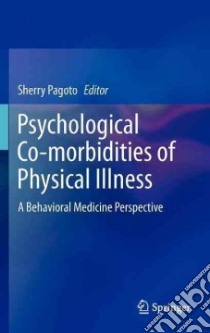Psychological Co-Morbidities of Physical Illness - 9781441900302
Un libro in lingua di Pagoto Sherry (EDT) edito da Springer Verlag, 2011
- € 174.30
- Il prezzo è variabile in funzione del cambio della valuta d’origine
Evidence for the efficacy of behavioral approaches to the treatment and management of physical illness is mounting, as is the evidence for behavioral interventions for psychological disorders. A pressing question that remains is how to effectively treat co-morbid physical and psychological illnesses. Diseases co-occur more often than not, and the co-occurrence of physical and psychological illnesses is associated with greater impairment and healthcare costs. Unfortunately, the treatment literature has traditionally been disease-specific, with fewer insights and discoveries regarding the underlying processes of co-morbid physical and psychological illnesses, and even fewer of approaches to treatment.Research on co-morbidities between physical and psychological illnesses has focused primarily on depression. Quite extensive literatures describe the negative impact of depression on type 2 diabetes, cardiovascular disease, cancer, obesity, pain, and other physical illnesses. More recently, higher rates of physical illness have been documented in individuals with bipolar disorder, anxiety disorders, schizophrenia, and impulse control disorders. Studies emanating from the National Comorbidity Survey-Replication (NCS-R), the only U.S. population-based database that includes diagnostic information on all DSM-IV psychological disorders, have revealed strong links between a number of physical and psychological illnesses. These data draw attention to the prevalence of physical and psychological co-morbidities at the population level, which has stimulated research on the biobehavioral mechanisms of those co-morbidities, with the goal of developing and improving treatment approaches. As this area of research grows, practical resources are needed for clinicians and researchers who encounter individuals with co-morbid physical and psychological illnesses in their work. This book is the first to provide a comprehensive overview of psychological co-morbidities of physical illness, biological and behavioral mechanisms of those co-morbidities, and implications for treatment. Each chapter focuses on a physical condition, such as obesity, type 2 diabetes, HIV infection, tobacco dependence, cardiovascular disease, cancer, asthma, pain, irritable bowel syndrome, autoimmune disorders, and obstetric/gynecological conditions. Chapters are structured to cover 1) the epidemiology of the most prevalent co-morbid psychological disorders within that physical condition (e.g., depression and other mood disorders, anxiety disorders, psychotic disorders, impulse control disorders, and eating disorders; 2) biobehavioral mechanisms of the co-morbidity; 3) a review of the behavioral treatment literature including evidence-based practice guidelines (where available); and 4) treatment considerations including issues of stepped care, evidence-based treatment decisions, treatment sequencing, treatment blending, treatment interactions, and contraindications. Content is guided by available research evidence and relevant theoretical models, and it is presented in such a way as to inform clinical practice, identify important gaps in the research literature, and provide directions for future research. The book serves as a tool for clinicians and researchers who work in the area of behavioral medicine in medical, academic, and/or training settings. Patients with psychological and medical co-morbidities may be encountered by clinicians working in either mental health or medical settings, where the presenting problem could be either the psychological disorder or the medical disorder. As such, assessment and treatment issues are discussed from both perspectives. For the clinician, the book reviews brief assessment tools, provides practical summaries of the treatment outcome literature and treatment considerations (e.g., treatment sequencing, contraindications), and includes treatment decision hierarchies that help the clinician incorporate each facet of evidence-based decision
Informazioni bibliografiche
- Titolo del Libro in lingua: Psychological Co-Morbidities of Physical Illness
- Sottotitolo: A Behavioral Medicine Perspective
- Lingua: English
- Autore: Pagoto Sherry (EDT)
- Editore: Springer Verlag
- Collana: Springer Verlag (Hardcover)
- Data di Pubblicazione: 15 Settembre '11
- Genere: MEDICAL
- Argomenti : Comorbidity Behavior therapy Dual diagnosis Treatment
- Pagine: 466
- ISBN-10: 1441900306
- EAN-13: 9781441900302


